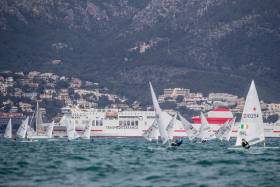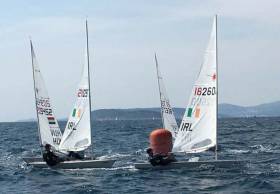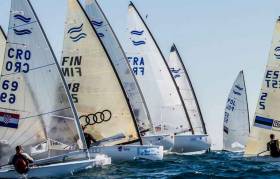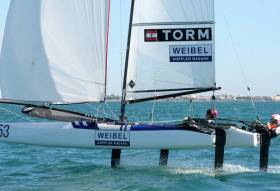Displaying items by tag: olympic sailing
Finn Lynch, Ireland's only gold fleet participant at last week's important Trofeo Princesa Sofia Regatta, recovered ten places or so in the closing stages to finish with a 2 and a 9 in 'very hard' conditions.
The two top ten results put the National Yacht Club man into 30th overall, an improvement on what the County Carlow man regards as a 'frustrating' result, due to 'a few big mistakes'.
Lynch's next port of call on the road to Tokyo 2020, is the Hyeres World Cup event in a few weeks time.
2018 Trofeo Princesa Sofia Iberostar
Australia's world champions Mat Belcher and Will Ryan, outstanding winners of a strong, competitive 470 class, were awarded the Princesa Sofia Trophy, the top overall award at the biggest ever edition, as the 49th Trofeo Princesa Sofia Iberostar concluded in light, hesitant breezes in Mallorca today. The regatta attracted 870 boats from 62 different and more than 1200 sailors.
The 2016 Olympic silver medallists won the tricky medal race today to cap an impressively consistent performance, counting all their results inside the top 10 in a high scoring regatta, to win by 39pts ahead of Turkey's Deniz and Ates Cidar. Japan's winners of the class last year at this Balearic showcase regatta Tetsuya Isozaki and Akira Takayanagi finished third.
For eight times world chammpin Belcher, winning the top overall award at a personal favourite regatta, one he has been coming to since the first time as a 19 year old in 2001,is a particular pleasure. He wins the class for the fourth time.
Top three final results:
470 Men
1. Mathew Belcher / William Ryan, AUS, 23 points
2. Deniz Cinar / Ates Cinar, TUR, 62
3. Tetsuya Isozaki / Akira Takayanagi, JPN, 66
470 Women
1. Ai Kondo Yoshida / Miho Yoshioka, JPN, 56
2. Hannah Mills / Eilidh Mcintyre, GBR, 58
3. Linda Fahrni / Maja Siegentahler, SUI, 59
49er
1. Yago Lange / Klaus Lange, ARG, 93
2. Dylan Fletcher-Scott / Stuart Bithell, GBR, 96
3. Mathieu Frei / Noe Delpech, FRA, 97
49er FX
1. Annemiek Bekkering / Annette Duetz, NED, 47
2. Alexandra Maloney / Molly Meech, NZL, 95
3. Odile Van Aanholt / Marieke Jongens, NED, 97
Finn
1. Giles Scott, GBR, 57
2. Nicholas Heiner, NED, 84
3. Andy Maloney, NZL, 95
Laser
1. Matthew Wearn, AUS, 55
2. Sam Meech, NZL, 64
3. Tonci Stipanovic, CRO, 98
Laser Radial
1. Anne-Marie Rindom, DEN, 59
2. Alison Young, GBR, 74
3. Maria Erdi, HUN, 91
NACRA 17
1. Ruggero Tita / Caterina Banti, ITA, 51
2. Ben Saxton / Nicola Boniface, GBR, 77
3. Fernando Echavarri / Tara Pacheco, ESP, 90
RS:X Men
1. Pawel Tarnowski, POL, 34
2. Louis Giard, FRA, 36
3. Sebastian Fleischer, DEN, 48
RS:X Women
1. Lilian De Gues, NED, 38
2. Pei Na Chen, CHN, 49
3. Flavia Tartaglinik, ITA, 65
J80
1. Javier Chacartegui, ESP, 5
2. Sebastian Allebrodt, GER, 11
3. Pablo Ariel, ESP, 17
Dragon
1. Otto Pohlmann, UAE, 11
2. Stephane Baseden, FRA, 17
3. Javier Scherk Serrat, ESP, 20
The Tokyo 2020 Olympic Sailing Competition will be held out of Enoshima Yacht Harbour, also the venue for Sailing's World Cup Series event this September, and will feature 350 athletes racing in 250 boats across the ten Olympic events.
With a silver medal in the bag from Rio, Irish sailing has big hopes for Annalise Murphy, Finn Lynch and a host of new sailing stars, that were in action last week in Palma.
As hosts, Japan receives automatic entry into each event.
As Afloat.ie previously reported, the Hempel Sailing World Championships will be the first opportunity for sailors to qualify for Tokyo 2020. In Denmark, 101 places, 40% of the total quota, will be available for the highest finishing nations. Listen to the recent Afloat.ie podcast on Ireland's chances with Olympic Team Manager, James O'Callaghan.
Six places will be available in the Men's and Women's One Person Dinghy at the 2018 Asian Games and 2019 Pan Am Games.
Class Association World Championships in 2019 will see the awarding of 61 places and throughout the remainder of 2019, moving into 2020, Continental Qualification events will be held to decide the remaining 68 places.
Two Men's One Person Dinghy and two Women's One Person Dinghy spots will be awarded to eligible National Olympic Committees (NOC) through the Tripartite Commission Invitation Places. The International Olympic Committee will invite eligible NOCs on 14 October 2019 to apply for these places.
Each NOC may enter a maximum of one boat per event, a total of 15 athletes (eight men and seven women) at the Tokyo 2020 Olympic Sailing Competition.
Download Tokyo 2020 Sailing Competition Qualification System below
Finn Lynch Makes Gold Fleet But Trofeo Princesa Sofia Reveals Irish Olympic Sailing Crews Have 'More Work To Do' Before Aarhus
With two more days of racing at the Trofeo Princesa Sofia Regatta at Palma, the large Irish team there will be keen to make the most of the experience in the heat of strong competition given the countdown is on for the World Sailing Championships in August, where 40% of all Tokyo 2020 Olympic berths are up for grabs.
Irish Sailing Performance Director James O’Callaghan predicted last month two Olympic berths can be secured for Ireland at the World Championships in Aarhus but if Palma is anything to go by this week, then it still looks like a work in progress for Team Ireland.
'At the midway point in Palma, it's clear the Irish teams still have a lot of work to do before August', O'Callaghan admitted on social media. Still, there were also some positives coming from back from Mallorca.
Perhaps the most encouraging sign came from Rio rep Finn Lynch in the qualifying stages for the gold fleet of the Mens Laser class. Lynch is now working with a new coach, Olympic medalist Vasilij Žbogar has joined Irish Sailing’s High Performance Squad as Laser coach.
All four Irish 49er skiffs had some good individual races but ultimately too many starting penalties cost dearly and meant none of the Irish progressed to the gold fleet, leaving double Olympian Ryan Seaton to conclude "It’s been a difficult two days for us and it’s so easy to make excuses or to simply judge how we are sailing based on looking at some results".
Results from Trofeo Princesa Sofia Regatta at Palma can be found here
National Yacht Club Laser Sailor Finn Lynch spent eight hours on the water for a single race yesterday at the 49th Trofeo Princesa Sofia Regatta but he made it well worth his while by placing seventh in a strong turnout of the mens Olympic Laser class.
49er development squad duo Sean Dickson and Robert Waddilove of Howth Yacht Club also made the most of flukey opening day conditions and are top of the four Irish 49ers competing after three races.
Irish Olympic sailing hopes are well represented in Palma, a warm-up before the all important World Sailing Championships in August where Tokyo Olympic berths are up for grabs.
The Irish 49er and Laser teams compete this week and an Irish Finn is in the line-up too, with 1000 sailors, 840 boats and 64 nations competing for Spanish honours.
Irish Olympic sailing hopes are well represented in Palma, a warm-up before the all important World Sailing Championships in August where Tokyo Olympic berths are up for grabs.
Results in all classes are here
The light, unsettled breezes on Mallorca's famous Bay of Palma presented a really testing opening day. With a maximum eight race courses in operation it was often the case that one fleet was sturggling in next to no breeze while classes on the opposite side of the substantial bay was enjoying good racing in 10kts of wind
So the record sized, full capacity Laser fleets, a total of 300 Standard and Radials, only managed one single race while the 49er, FX and Nacra 17 classes still hit their scheduled three race target for the first day.
There was something of a dream return to the 49er class for Denmark's 2008 Olympic gold winner Jonas Warrer. After finishing fourth in Rio Warrer, who has just turned 39, took time out from the men's skiff class and has been focused on M32 racing. But the chance to partner with 19 year old fellow Aarhus sailor Jakob Precht Jensen has re-ignited his Olympic dream, not least to pursue World Championship success this summer on their home waters.
The Danish duo opened their first ever Olympic regatta together with two wins and a discarded 10th to lead the Men's Skiff fleet after three races.
"When you are half way up the first beat of the first race and the second guys are more than 50 metres behind then that is a good feeling." grinned Warrer in the boatpark at the CNA S'Arenal, "And then making two first places really made our day. We started opposite from the pack and lead from start to finish of both races. But, then tomorrow, it can be a different story. But we are confident. We are doing things right and I think we have good speed."
Warrer and Precht Jensen have been together since October but have had little time together in the boat. The Qingdao gold medallist is mixing this programme with coaching different teams. They had a week of training in India as well as time in chilly Denmark when they set out together.
"We are both from Aarhus and so that is a big, big thing for us this year. And then the Olympics is the goal beyond that. We have a good group in Denmark, more than last time."
Warrer last won the Trofeo Princesa Sofia regatta in 2012 with Soren Hansen but missed out on a close selection battle for the London 2012 Olympics where compatriots Allan Nørregaard and Peter Lang won bronze.
"We have a good chemistry and we fit each other well. We have not done a regatta of any type together up until today and so we could not really have hoped for a better start. But tomorrow is another day." Precht Jensen commented.
If the Danish duo had a dream start, the first day of the 49th Trofeo Princesa Sofia Iberostar was also something of a baptism of fire for Britain's Nicola Boniface in the Nacra 17 fleet. Drafted in to partner world championship winning helm Ben Saxton after an injury sidelined crew Katie Dabson, Boniface proved herself up to the task as they sailed 2,1,3 for the day to lie third after the discard is applied. Italy's 2017 Nacra 17 World Championship bronze medallists Ruggero Tita and Caterina Banti lead from Argentina's Olympic champions Santi Lange and Cecilia Carranzas Saroli.
"This was really last minute. I arrived yesterday and have not sailed for four months. We had a quick sail for an hour yesterday. It is nice to be back in the boat and the conditions were beautiful, not too physical. Ben and I have been mates for a long time but we are just learning how it works in the boat together. We will just try to enjoy the week and to learn and hope Katie gets better soon." Boniface explained.
Posting a pair of single figure scores in the ultra competitive 470 fleets proved especially tough. Japan's Naoki Ichino and Takashi Hasegawa lead France's Kevin Pepponet and Jeremie Mion in second with GBR's 2012 silver medallist Luke Patience and Chris Grube in third. After bigger breezes at January's Sailing World Cup Miami, where Patience and Grube won from the French duo, Pepponet and Mion were especially pleased to be going well in today's light conditions.
"It was so tough, very shifty with light winds." said Peponnet, "We have a good sensation on the boat even if we have trained in stronger breezes through the winter. So that is pleasing. The last two days have been good in practice so we feel good. We are liking the light breeze."
Mion lifted the 470 European Championship on these Bay of Palma waters two years ago and won this regatta with Nicolas Charbonnier in 2011.
In the 470 Women Switzerland's Linda Fahrni and Maja Sigenthaler who finished fourth here last year open their Sofia campaign with the regatta lead, thanks to a third and a second place.
"It was difficult, shifty and moving around a lot but we had a good start and lead early on the first race, second race was not so good. But it is the first day. Our aim is just to get to the Medal Race and see how we can do. We are looking mainly to getting the nation qualified at the world championships in Aarhus." helm Fahrini commented.
Reigning gold medallist GIles Scott (GBR) was pleased to have 'survived' what proved to be a pretty marginal first day of racing in the tough Finn class, coming away with a solid sixth and ninth to lie second two points behind Spain's Alejandro Muscat.
"Surviving is the word. We had surprisngly windy conditions from the north when we went out but knew it would do the big swing which it did. So from two reasaonably light races, the second one was especially difficult with big shifts and a big pin end biased line. We just got done before the wind shut off completely." Scott explained,
"This is my second event after Miami and I'll go to Hyeres and to Marseille and then Aarhus. Here I am just working on things, little specifics. Events like this are great to work on what you think might be your next gain and then come back to the fleet. That is how the majority of the fleet operate and so why events this are so popular."
Scott adds:
"It is pretty difficult because I am juggling a few balls at the moment. I think it is good for me as long as my time management is good and I am putting all the hours in that I can. I enjoy to stay busy and stay fresh and to keep learning in other areas of the sport. The difficulty is in just managing your time commitment. It is refreshing to be back racing on your own. It is so different and this class is so tactical. You have to be on every decision you make in Finn racing, you just don't get away with mistakes."
New Zealand's Olympic silver medallists Alexandra Maloney and Molly Meech lie second in the 49er FX class counting a 2,1 to the Netherlands' leaders Annemiek Bekkering and Annette Duetz who won here last year and opened by counting two firsts.
Meech reported, " It was hard racing, a real eyes out of the boat day looking for the best pressure. We had pretty good starts which is good because we have been working hard on them. And I think we were good at staying calm today, being patient. We have come here after a really good summer at home in New Zealand. We had a good break and then our 49er fleet have been there and some of the international girls came down - the Norwegian girls and the Australians came across for our local regattas so that was god for us. And then the announcement we will get the World Championships in New Zealand next year added a really cool buzz to things down there."
Meanwhile in the Laser class her bronze medal winning brother Sam Meech won the first race in his flight as did Australia's Finn Alexander and Britain's Lorenzo Chiavarini. Women's flight winners were Switzerland's Maud Jayet and Hungary's Maria Erdi. China's Bing Ye, the world champion, won the only race for the RS:X men and compatriot Pei Na Chen leads from the returning British sailor Bryony Shaw, 2008 bronze medallist.
Irish Laser Sailors Facing 'Tough' Test in Palma
Irish Olympic Laser campaigners Finn Lynch of the National Yacht Club and Liam Glynn of Ballyholme Yacht Club will face a fleet of 183 and all three Rio medallists when they start racing at a bumper 49th Trofeo Princesa Sofía Iberostar in Palma today, the first test of new Laser coach for Ireland, Vasilij Žbogar.
In a large turnout across the Olympic sailing classes for Ireland, previewed in full here, Aisling Keller in the Laser Radial will also meet Dutch 2016 gold medallist Marit Bouwmeester who took silver in London racing her first major regatta of this year.
'Racing kicks off at 11.00 today. 180 lasers entered! It should be a great week! says Lynch on the eve of the regatta while Glynn admits it's likely to be 'a tough week ahead racing 180 of the world's top sailors, but determined to start the racing season on a high'.
Following last year's post-Olympic entry of 634 boats and 842 sailors the expected spike in numbers continues an underlying upward trend. Entries last year were 10% ahead of where they were in 2013, that was immediately post London, and in 2017 were more than 20% ahead of 2009, post Beijing.
"The regatta this year is bigger than four years ago and so from the sports point of view is in a good position." highlights the event's manager Ferran Muniesa, "But the most important thing is what the sailors say to us all the time, that feel really comfortable at this event and that is important. They are our clients and we are seeking to give the best possible service to them."
The direct effects for the local economy are significant during tourism's realtively low season. A recent impact survey accounted for a income of around €4.5m to the local economy spread over the month prior to the event and during competition week.
Muniesa adds, " Long term locally what we really want is to show to the people of Mallorca and to the government of the Balearic Islands that this is an event which does a great promotion around the world for Mallorca and creates a significant impact - not only in terms of image but the economic impact is important because of course this happens low season. "
He adds, " From today we start the campaign to reduce the plastics and to educate and engage the sailors to tell them that they are the first ones that can set an example to everyone. That is why with our sponsors Iberostar and Marinepool and the Foundation One Earth One Ocean we are trying to see how we can help. This is a long term vision and this year we get started."
To sailors on all stages of their Olympic journey the lure of these Balearic waters remains as strong as ever. The event is renowned for pleasant sunshine, consistent, reliable spring breezes, excellent race management and it also holds the opportunity to put in several weeks of pre-regatta training in - usually - sunshine and a variety of winds.
With two years now until the 2020 Tokyo Olympics the 49th Trofeo Princesa Sofía Iberostar regatta is an almost essential fixture. No fewer than 17 sailing medallists who stood on the Olympic podium in Rio in 2016 will compete against dozens of previous Olympic medallists and World and European Champions. But the event is a fascinating melting pot where young talent can emerge and impress at one of their first big stage Olympic multi class events.
"It is wonderfully organised with a great atmosphere ashore but on the water there is a nice air of, well, anarchy. Here you often find loads of young guys and girls here to prove themselves and really push everything hard. And so for us, and others like us, this is always a chance to try new things, different equipment or tecniques, to work on things as for us the outcome is not critical." summarises the 2012 470 Olympic silver medallist Luke Patience with a trademark grin.
That said the 49th Trofeo Princesa Sofía Iberostar regatta marks the start of the journey for country qualification for Japan leading up to this season's World Championships of Aarhus.
The all time participation record sees eight regatta courses due to be operated across the Bay of Palma with starts and finishes almost continuously through each day. Target schedule for the Laser, RS: X and Finn is 10 races over in five days, while the Nacra 17, 49er and 49er FX have 15 races scheduled. Then, next Saturday, April 7, the decisive Medal Races for each classes should determine the overall podiums.
Who's Who? More than 20 Rio Medallists.....
In the Men's 470 Class Miami winners Patience and Chris Grube will be up against Australia's 2017 world champions and 2016 Olympic silver medallists Mathew Belcher and Will Ryan who won here two years ago and Rio bronze medallists Greece's Mantis Panagiotis and Pavlos Kagialis.
Rio gold medal winning helm in the 470 fleet Hannah Mills competes with Eilidh McIntyre with whom she finished runner up at the World Championship. Similarly France's Camille Lecointre who sails now with Aloise Retornaz won Olympic bronze in Rio.
British crews have achieved something of a domination in the 49er class even if medals have proven elusive at recent Olympics. Dylan Fletcher-Scott and Olympic 470 silver medal winning crew Stu Bithell are current world champions and won gold at the Sailing World Cup Miami in January. Germany's Olympic bronze medal winner Thomas Ploessel now races in a new partnership with Justus Schmidt. The young Spanish duo Diego Botin and Iago L. Marra finished runners up in Miami and were second here last year behind the British winners James Peters and Fynn Sterrit who sadly miss the chance to repeat their success because of a last minute injury to crew Sterrit.
In 49er FX the New Zealanders Alexandra Maloney and Molly Meech and the Danish duo Jena Mai Hansen and Katja Steen Salskov-Iversen start among the favourites. Maloney and Meech won Olympic silver in Rio while Hansen and Salskov-Iverson hold Olympic bronze from 2016 and lifted the world champions title in 2017.
The Finn class is perhaps one of the hardest to call. GBR's recently crowned European Champion Ed Wright is up against Rio gold and silver medal winners Giles Scott (GBR) and Caleb Paine (USA) along with the Swede Max Salminen who is world champion.
The Laser fleet is the biggest at the regatta with 183 registered boats and all three Rio medallists are racing here. Outstanding favourite appears to be Tom Burton, gold winner in Rio 2016, world championship runner up and the class winner at the Sailing World Cup Miami. Croatia's Tonci Stipanovic took silver in Rio and New Zealand's 2016 bronze medallist Sam Meech won the first of the 2018 Sailing World Cup events in Japan.
The Laser Radial class is 117 strong with the Dutch 2016 gold medallist Marit Bouwmeester who took silver in London racing her first major regatta of this year. She holds the aces as World and European Champion. Denmark's Anne Marie Rindom is the bronze medallist in Rio, winner of the first regatta of the 2018 Sailing World Cup and finished third here when she last raced in 2016. Great Britain's Alison Young, the 2016 world champion, comfortably triumphed at the Sailing World Cup regatta in January.
In the Nacra 17 the introduction of foils has opened up the class again forcing a new style of sailing to be learned. Argentines Santiago Lange and Cecilia Carranza, the Olympic champions in Rio 2016 are on that learning curve and have yet to replicate their Rio success on foils. World Champions are GBR's Ben Saxton and Nicola Boniface, the first world title winners on foils, who were sixth here last year. The Nacra 17 also features Austria's bronze medallists Thomas Zajac and Barbara Matz while Spain's Fernando Fernando Echávarri and Tara Pacheco are 2017 world championship runners up.
The men's boards are the only class in which none of the medallists of the last Olympic Games are present at the 49th Trofeo Princesa Sofía Iberostar. Poland completed the double last year when Pawel Tarnowski won the Men's RS:X, following up from his second in 2016. World Champion Bing Le leads a strong Chinese contingent as does Women's World Champion Pei Na Chen in the female fleet. Spain's London 2012 gold medallist Marina Alabau has finished fourth twice here.
The Trofeo Princesa Sofía Iberostar has signed a collaboration agreement with the One Earth - One Ocean foundation to help protect the oceans and coastal waters. The initiatives begin at this edition, by reducing the use of plastics and by collecting waste from the sea and the beach. In addition, the organization has distributed to all the on the water personnel and participating coaches a device to prevent of fuel and oil going in the sea from the RIB’s engine.
Irish Olympic Sailing Hopes in 49er, Laser, Radial & Finn Ready for Trofeo Princesa Sofia Regatta
Irish Olympic sailing hopes are well represented in the Trofeo Princesa Sofia Regatta in Palma tomorrow, a warm-up before the all important World Sailing Championships in August where Tokyo Olympic berths are up for grabs.
The Irish 49er and Laser teams compete this Friday 30 March and an Irish Finn is in the line-up too, with 1000 sailors, 840 boats and 64 nations competing for Spanish honours.
Four Irish 49ers
Four Irish 49er teams are in Palma with top boat Ryan Seaton and Seafra Guilfoyle expecting to reap the benefits of some winter training at the Spanish venue and ready to put some painful injuries behind them. Also in Palma are duos Sean and Tadgh Donnelly; Robert Dickson and Sean Waddilove; Mark Hassett and Oisin O'Driscoll.
Finn Lynch looks for Upwind Speed
Liam Glynn and Finn Lynch take part in the mens Laser class with Lynch looking for a speed improvement upwind under new Irish Laser coach, three-time Olympic medallist Vasilij Žbogar
Aisling Keller will be the sole Irish Radial sailor with Annalise Murphy still on Volvo Ocean Race duty and Aoife Hopkins recovering from a bout of tonsillitis.
Oisin McClelland competes in the Finn class, after a strong performance earlier this month in the Europeans in Cadiz where the Northern Ireland helmsman finished just outside the top third of his 90–boat fleet.
Fionn Lyden Sits Out Palma Due to Exams
Ireland's U23 Finn Champion Fionn Lyden is not competing. Palma wasn't part of his original plan, as its too close to his finals infourth year in Civil Engineering in UCC. Lyden has, however, regained most of the weight he lost at the camp in Valencia through illness earlier this year, so he should be back in good condition when he goes full time Finn sailing, just after the exams in May.
Expect 'Rustiness'
James O'Callaghan, Irish Sailing Performance Director reckons there will be 'some rustiness' but the team will get some good insights as to what's required for the World Championships in Aarhaus. O'Callaghan recently gave an overview of team status in a podcast on Afloat.ie here.
Ireland's Olympic Laser sailing team has a new multi–medal winning Slovenian coach but will he boost Finn Lynch's upwind speed in a breeze? Is Annalise Murphy going to swap her world–girdling adventures for a chance of Tokyo gold anytime soon? The answer to these questions and the prospects of Irish Olympic Sailing campaigns are discussed by High Performance Director James O'Callaghan in the Afloat.ie podcast below.
In ten Olympic sailing disciplines, Ireland will contest four at the World Sailing Championships in Aarhaus this August where over 100 nations are racing for 40% of Tokyo Olympic Games berths.
With five months to go to that big event, O'Callaghan gives an overview of just what is required to win an Olympic berth at the first opportunity and concludes he'd be 'happy' to see Ireland secure two Olympic spots in Denmark.
Listen in to the podcast below.
Laser – Finn Lynch | Liam Glynn | Ewan McMahon | Johnny Durcan
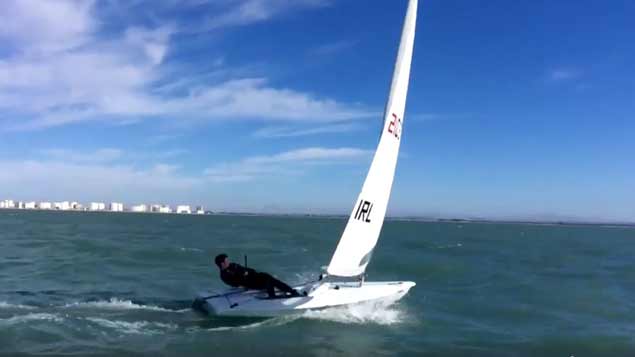 Former Topper World Champion Liam Glynn is chasing Olympic nomination in the Laser. A top 25 of the Mens Laser fleet will be required for Olympic Qualification in Aarhaus Photo: Facebook
Former Topper World Champion Liam Glynn is chasing Olympic nomination in the Laser. A top 25 of the Mens Laser fleet will be required for Olympic Qualification in Aarhaus Photo: Facebook
In something of a 'coup' for team Ireland, Irish Sailing has appointed a new Olympic medal winning Slovenian coach to assist Finn Lynch's quest for improved heavy weather upwind speed. After this Summer's Leaving Certificate, the Rio Laser helmsman will have more Irish company on the circuit too. Howth's Ewan McMahon, Royal Cork's Johnny Durcan are scheduled to join Lynch and Belfast's Liam Glynn in a new Irish mens Laser training group under star coach, Vasilij Žbogar.
Radial – Annalise Murphy | Aoife Hopkins | Aisling Keller
 After sailing round the world in the Volvo Ocean Race, Annalise Murphy's stated return to the Radial is much anticipated. Photos: Facebook
After sailing round the world in the Volvo Ocean Race, Annalise Murphy's stated return to the Radial is much anticipated. Photos: Facebook
 Aoife Hopkins during fitness testing at the Sport Ireland Institute. Photo: Facebook
Aoife Hopkins during fitness testing at the Sport Ireland Institute. Photo: Facebook
Is it certain Olympic Silver medalist Annalise Murphy will be back to campaign for Tokyo? Murphy is currently sailing in the 'life changing' Volvo Ocean Race but O'Callaghan says the National Yacht Club star is expected to return Radial duty this Summer. The Rio star can expect some home competition this quadrennial from recently carded sailors Aoife Hopkins and Aisling Keller, both embarking on brand new campaigns post Leaving Cert.
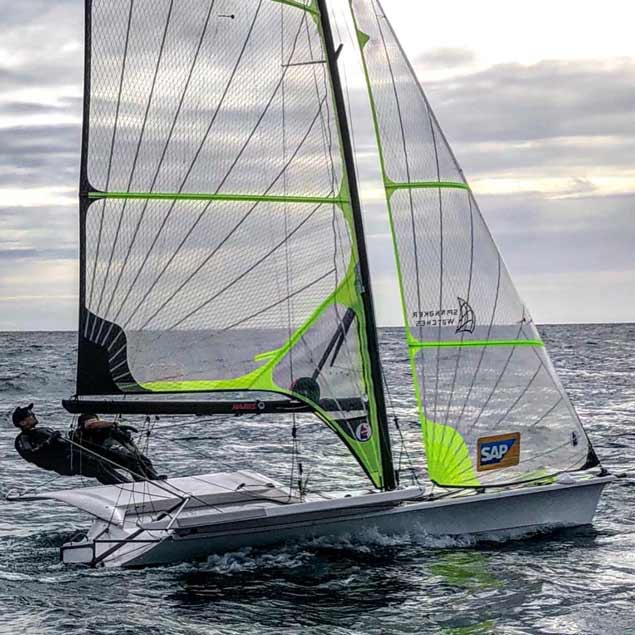 Ryan Seaton and Seafra Guilfoyle training in Palma this week. Photo: Facebook
Ryan Seaton and Seafra Guilfoyle training in Palma this week. Photo: Facebook
49er – Ryan Seaton & Seafra Guilfoyle
There have been setbacks for the 49er pairing of Ryan Seaton and Seafra Guilfoyle – including a cycling accident but the expectation is that 2018 can produce results under a new coach. A top ten overall to qualify in Aarhaus will be a tough prospect but it's nothing Belfast's Seaton hasn't done before in his build–up to London and Rio. Meanwhile, Irish Sailing's 49er Development team have all been training in Palma in advance of the Princesca Sofia Regatta there this week.
Finn – Oisin McClelland | Fionn Lyden

A question mark may hang over its future Olympic status but that's not stopping two Irish campaigns from securing a mens heavyweight berth in Tokyo. Oisin McClelland from Donaghdee is currently racing for European Honours in Cadiz while illness rules out Baltimore's Fionn Lyden this week. As the only Olympic class that is not mixed-gender, the heavyweight Finn dinghy is looking most likely for the chop when World Sailing decides on its Paris 2024 fleets later this year. The response at this week’s Finn Euros has been the launch of the #myfutureisinyourhands campaign, with Ireland’s now sole entry, Oisín McClelland, posting on Facebook: “The future of Olympic sailing looks set to eliminate anyone over 6ft and 85kgs. Plenty of Finn sailors are upset about it.” Not that the Donaghdee star is leaving his Tokyo 2020 fate in the hands of others — as his bright start on Day 1 of the Cadiz regatta proved.
470, Finn, & RSX Classes Will Be Reviewed For Olympic Sailing Regatta 2024
Reports today from the International 49er class say World Sailing will put up for review the events represented by the 470 M/W, Finn, and RSX M/W. By choosing not to review the other 5 events; Laser/Radial, 49er/49erFX, and Nacra 17, these events and the current equipment will remain for the games in Paris.
"We are thrilled with this result," said president of 49er and Nacra 17, Marcus Spillane. "The political security this decision provides will allow us to focus on serving our sailors and sport by providing fair and entertaining racing for all to enjoy!"
The decision itself was very close, with 21 for and 17 against, showing how divided World Sailing Council is on the future of the sport. Just a few months ago, Theatre Style Racing format was defeated 20 to 21 by the same body, which was in some ways a precursor to this vote. How sailing comes together over the next two phases of this process will have a major impact on the strength and stability of Olympic Sailing for years to come.
The impetus for reviewing events derives from two IOC initiatives:
The IOC now reviews events, not just sports - each event must stand up to that level of scrutiny.
World Sailing has agreed to both participation and event gender equaility - since the 2020 events do not balance, change is required to comply.
Putting events up for review is the first part of the process World Sailing has agreed to in order to make the change. There are three major sections of work:
Phase 1 - Decide what to review, and by default what would remain. The minimum number of boats up for review, by rule, was 4. The decision today is to review 5.
Phase 2 - Decide the Events (high level description of what the racing should be) for the balance of the 5 events. This begins in Mid-March and concludes in a vote at the World Sailing mid-year meeting on May 15th in London.
Phase 3 - Decide which equipment should be used by the nominated events. This vote can occur at the November 2018 meeting, with provisions to extend for an additional year if new boat designs are required.
Of the ten events and 350 athletes destined for Paris 2024, half are now known. The work begins to select both the Events and Equipment to fill the remainder of the slate.
The next step is the high level phase, where sailing will decide what to aim for while balancing a huge variety of factors. As we enter a phase of uncertainty for many current and aspiring Olympic sailors, and sailing as a whole, the task was outlined beautifully by Athlete Representative, Yann Rocherieux: "We trust in council to select events for 2024, where all sailors can have an opportunity to chase their dreams of becoming an Olympian, even if some sailors will have to change those another event than the one they are sailing now."
Nacra 17 Sailor in Hospital After Rudder Foil Strike
A Danish crew man, CP Lubeck, fell overboard and was struck by the rudder foil of his Nacra 17 while racing in New Zealand yesterday.
The injury required surgery. Lubeck is recovering well and will be back in action soon, according to Irish man Marcus Spillane, the President, of the International Nacra 17 Class Association.
Spillane adds 'We have been in contact with World Sailing and Nacra Sailing and are investigating the facts. This is a priority for the Class'.
Ocean Yacht Racing Goes Mainstream. Is Irish Sailing Ready? And Willing?
With three major yet very different marathon sailing events crossing the Atlantic this month, it’s clear that the once decidedly quirky and often eccentric devotees of offshore and ocean racing are becoming mainstream. This is further reinforced by the confirmation – which has been flagged for a long time now – that World Sailing and the Olympics organisation will be evaluating an experimental two-handed and possibly gender-mixed offshore contest in parallel with the sailing events at the Tokyo 2020 Olympiad. W M Nixon wonders if long-serving offshore racing enthusiasts will really be a hundred per cent in support of these developments.
In sailing as in politics, ultimately everything is local. We’d always been interested in the Mini-Transat, but never more than the time when Enda O’Coineen did it rather longer ago than he cares to remember. And when the second stage of this year’s race got going from Las Palmas to Martinique on November 1st, the hearts of the Irish sailing community were with our folk hero Tom Dolan, the farmboy from Meath who has shown he can cut it with the best of them in this uniquely demanding branch of the ocean game.
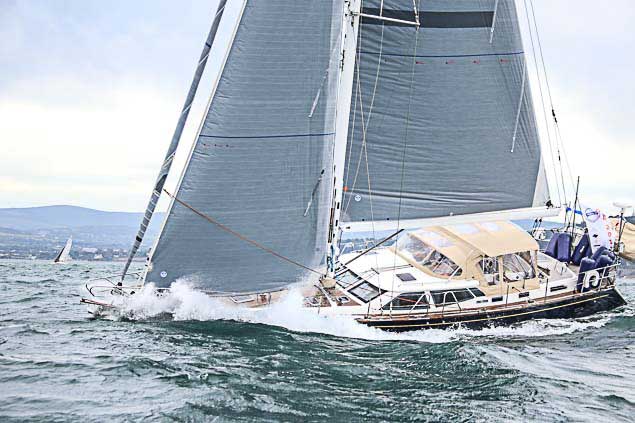 Never mind the weather, the tent is up and setting a treat…..Unlike the Mini-Transat boats which crossed the Atantic two weeks in advance of them, the crew of former Round Ireland winner Eamon Crosbie’s Discovery 55 Pamela will be enjoying considerable comfort during the ARC 2018. Photo David O’Brien/Afloat.ie
Never mind the weather, the tent is up and setting a treat…..Unlike the Mini-Transat boats which crossed the Atantic two weeks in advance of them, the crew of former Round Ireland winner Eamon Crosbie’s Discovery 55 Pamela will be enjoying considerable comfort during the ARC 2018. Photo David O’Brien/Afloat.ie
Then when the huge ARC 2017 got its incredibly varied fleet lumbering away last weekend, again from Gran Canaria, this time towards St Lucia, we tried to take an overview of the fleet, but inevitably became focused on Eamon Crosbie’s Discovery 55 Pamela from Dun Laoghaire with a merry crew on board. We’ve been observing that, like the rest of the fleet, she has found anything but regular northeast tradewinds out in the Atlantic, but she’s getting there nevertheless – race tracker here
This weekend, there’s some quite heavy metal – some of it distinctly luxurious in tone – getting started in the RORC’s Transatlantic Race from Lanzarote, with the finish in Grenada. The fleet of 23 make up in quality what it lacks in quantity, for though the smallest boat is the JPK 10.10 Jangada, the largest is Daniel Stump’s Southernwind 96 Sorceress, while the longest is Ludde Ingvall’s uber-skinny 98ft Maxi CQS from Australia.
It’s aboard this extraordinary yoke that Ireland’s Sailor of the Year 2013 David Kenefick, now 26, is sailing as skipper. In an acknowledgement to the sheer power and reach of the French sailing scene, the young Cork sailor had been declared “Rookie of the Year” in the Figaro Solo circuit in 2013, and to the surprise of some of the more traditionally-minded adjudicators, this was seen by the sailing public as more important than some major achievements within Ireland, so four years ago Kenefick became their Number 1.
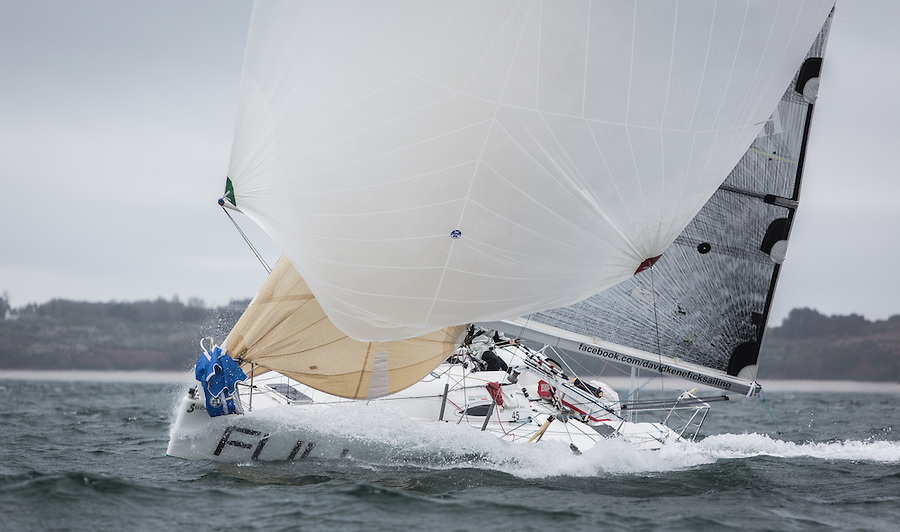 Somewhere in there on his Figaro Solo is David Kenefick, Ireland’s “Sailor of the year” 2013. Photo: Brian Carlin
Somewhere in there on his Figaro Solo is David Kenefick, Ireland’s “Sailor of the year” 2013. Photo: Brian Carlin
"Ludde is a legend and it is a great privilege to sail with him as skipper of CQS,” commented Kenefick. We have a young and multinational crew and we cannot wait to take on the challenge. CQS is a fantastic race boat and I am sure we are all going to learn so much after 3,000 miles.”
“In my early days I had the pleasure of racing with Harold Cudmore and we are still great friends,” said Ludde Ingvall. “I remember meeting with Harold and asking him what drives us on, now that we have been racing so many years. He replied we must 'pass it on' and that is what we are doing for young sailors that show great ability and the attitude to succeed.”
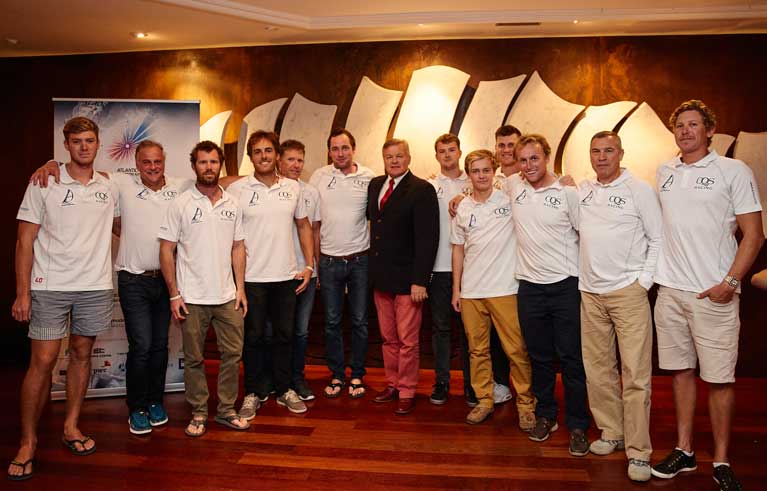 CQS crew – 26 year old Dave Kenefick pictured (centre) with Ludde Ingvall at tne gala dinner and his Australian 98ft Maxi CQS in the RORC Transatlantic Race starting from Lanzarote. Also pictured (fourth from left) is Royal Ulster Olympian James Espey
CQS crew – 26 year old Dave Kenefick pictured (centre) with Ludde Ingvall at tne gala dinner and his Australian 98ft Maxi CQS in the RORC Transatlantic Race starting from Lanzarote. Also pictured (fourth from left) is Royal Ulster Olympian James Espey
It will be intriguing to learn from one of our own just what it’s like to sail on something like CQS, which you can see as either counter-intuitive, or else so very intuitive that she has come out the other side. And with Kenefick on board, we will be keeping a special eye on her showing as the longest boat.
In between CQS and the “little” Jangada, there’s an eclectic selection including that old war horse, the Volvo 70 Monster Project (Roman Guerra). But generally they’re top end boats of comfortable size while being competitive at the same time. And with a considerable emphasis on European entries (there are boats from nine countries), they’re living proof that the story of the Eurozone’s economic recovery is true, and it’s out there and floating on the Atlantic.
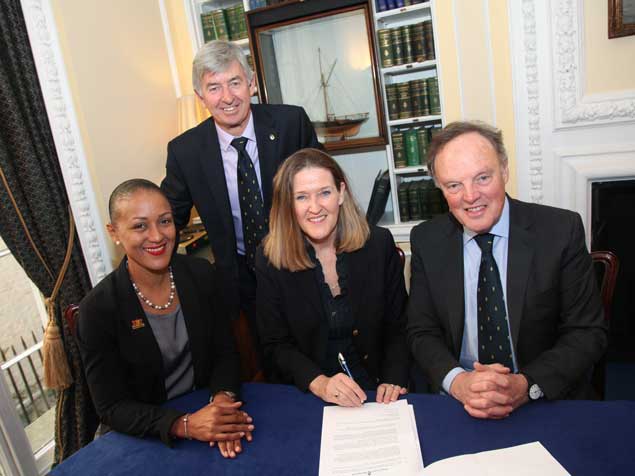 At the signing of the agreement to stage the RORC Transatlantic race from Lanzarote to Grenada are (left to right) Francine Stewart (Marketing Manager, Grenada Tourism Authority), Eddie Warden-Owen (CEO, RORC), Patricia Maher (Grenada Tourism Authority) and Michael Boyd (Commodore, RORC)
At the signing of the agreement to stage the RORC Transatlantic race from Lanzarote to Grenada are (left to right) Francine Stewart (Marketing Manager, Grenada Tourism Authority), Eddie Warden-Owen (CEO, RORC), Patricia Maher (Grenada Tourism Authority) and Michael Boyd (Commodore, RORC)
Typical of this is hyper-keen French owner-skipper Eric de Turkheim from La Rochelle, who we also feel is one of us, for if it hadn’t been for Rambler 88’s almost freakish performance in last year’s Volvo Round Ireland Race, his unusual-looking but effective Teasing Machine II would have been the overall winner.
Since then he has come up with the new 54ft Teasing Machine III, and though she wasn’t ready in time for the Fastnet Race in August, she made an impressive debut in the Middle Sea Race in late October, and would have been second overall if another of those pesky JPK 10.80s, this time the Russian-owned Bogatyr, hadn’t come out of the woodwork at the end, and snatched the win by six minutes, while Teasing Machine II was relegated to a close third overall.
So between CQS and Teasing Machine, we have favourites to follow. And although the RORC fleet start all of a week after the ARC, the winds along the sunshine route to the Caribbean are in such a wayward mood that it’s going to be fascinating comparing the relative performance of the two groups.
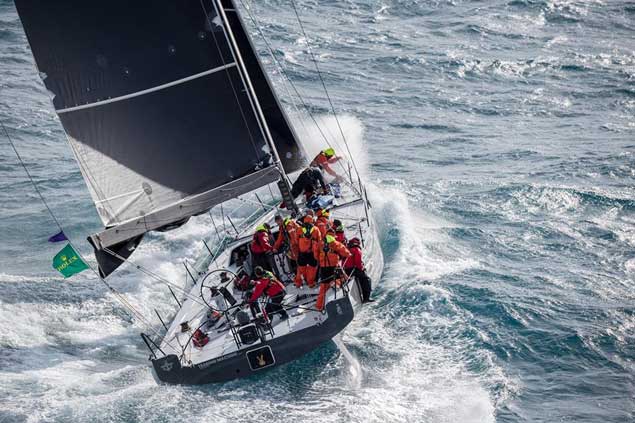 The new 54ft Teasing Machine II on her way to third overall in her first major event, the Rolex Middle Sea Race 2017. Photo Rolex
The new 54ft Teasing Machine II on her way to third overall in her first major event, the Rolex Middle Sea Race 2017. Photo Rolex
But what on earth, you might well wonder, is all this recitation of Atlantic voyagers and racers to do with giving only two instead of three cheers for the prospect of World Sailing shoe-horning offshore racing into the Olympics?
It’s simple. Offshore racing and its many organisations and events are so varied that trying to channel them into the narrow perspective of the Olympics, with its over-long four year cycle, is going to result in a very artificial construct. And the idea of having a man-and-woman crew of two who are declared to be the World Champions and Olympic Gold Medallists is so remote from the delicious, invigorating and multi-interest variety of the current offshore and ocean scene that we could be talking about two different planets.
For sure, it’s a notion which will appeal to newspaper headline writers. In the real red-top trade, sailing only makes sense when it’s in the Olympics or somebody is drowned. Beyond that, it’s simply too complex, varied and – let’s face it – self-absorbed, to promote itself as some sort of arena sport.
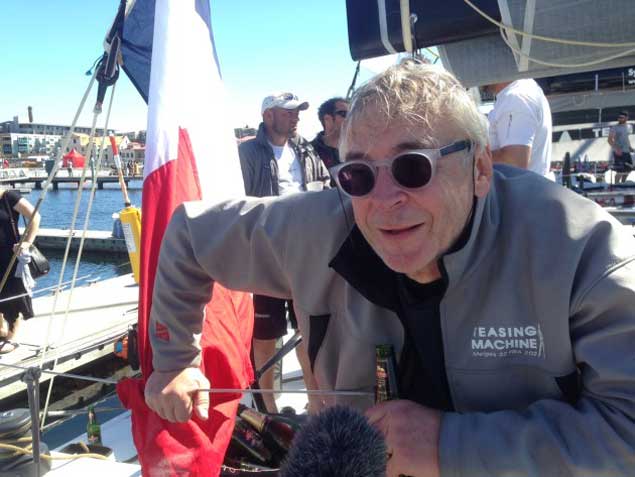 Eric de Turkheim, popular owner of Teasing Machine III, in Sydney preparing to race Teasing Machine II with success in the Sydney-Hobart Race
Eric de Turkheim, popular owner of Teasing Machine III, in Sydney preparing to race Teasing Machine II with success in the Sydney-Hobart Race
It was quite some time ago when two top honchos in American sailing announced that they were determined to reduce the number of world titles recognized by the then International Yacht Racing Union, which went on to become ISAF, and is now World Sailing. Back in the day, these guys reckoned that the 143 different IYRU-recognised classes with International status being each entitled to their own World Championship was a nonsense, and numbers should be reduced.
You can see why they thought so. One hundred and forty three sailing world champions might seem a bit over the top. But the idea went down like a lead balloon. People cherish their own classes, they cherish their own world titles, and they cherish their own local setup. And though they take a polite interest in World Sailing’s new look World Championship for Olympic classes, as it so often seems to be held on the other side of the world they’ll only engage if they happen to know of someone taking part.
So it’s complicated enough with inshore racing. But when you add in the extra factors involved in the much more complex and quirky world of offshore and ocean racing, it sometimes goes beyond understanding.
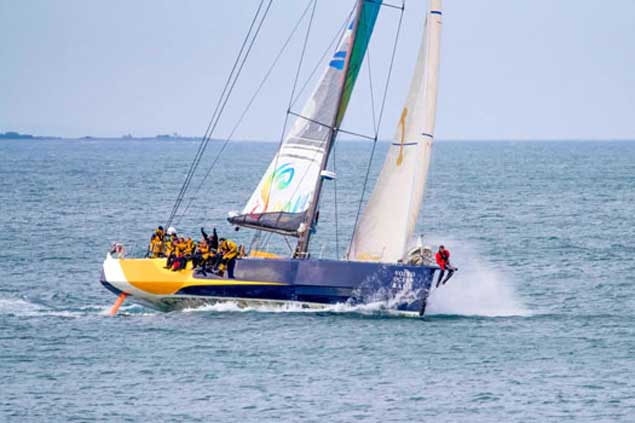 The old war horse. The Volvo 70 Monster Project coming to the finish to take line honours in the 2014 Round Ireland Race. She’s still going strong, and is one of the entries in the RORC Transatlantic Race. Photo WSC
The old war horse. The Volvo 70 Monster Project coming to the finish to take line honours in the 2014 Round Ireland Race. She’s still going strong, and is one of the entries in the RORC Transatlantic Race. Photo WSC
Yet the way things are provides something for everyone in the audience. While we pay lip service to approving the moves towards synchronising the IRC and ORC measurement systems, there’s a little bit of us that thinks it’s actually a pretty good idea having the two, as it allows for even more prizes, and they keep up the interest across a broader spectrum of the fleet.
Equally, an almost mind-numbing variety of events and organisations, a whole world away from the rigid one design format proposed for the Olympics offshore racing tryout, is what the global scene in the offshore game is all about. Think, for instance, of the 240 people from both sides of St George’s Channel who gathered at the Irish Sea Offshore Racing Association’s annual black tie dinner and prize-giving earlier this month in the National Yacht Club. All power to the great Peter Ryan for organising it, these were genuine sportsmen and women who are dedicated to their interest afloat, yet somehow trying to link them directly to the sterile world of the Olympics just doesn’t make sense.
At the other extreme, our own deservedly admired 2016 Olympic Silver Medallist Annalise Murphy instantly made herself much more interesting, much more of a three-dimensional character, when she courageously took on the crewing job aboard Turn the Tide on Plastic in the Volvo Ocean Race. There’s no doubt that having the fitness of an Olympic athlete is a real asset in a Volvo 65, but the concept of the Volvo Ocean Race is a million miles from Olympic theory.
In a different direction, sailing also includes the craziness of the America’s Cup, but in the offshore and ocean sphere, it’s generally agreed that the supreme event is the Vendee Globe. Nothing could be simpler in concept than one sailor on his or her own racing non-stop round the world out of a French port which finds it has stumbled on a world-beating event. Yet nothing is more complex than the actual machinations of the Vendee Globe, but the Olympic ideal it ain’t.
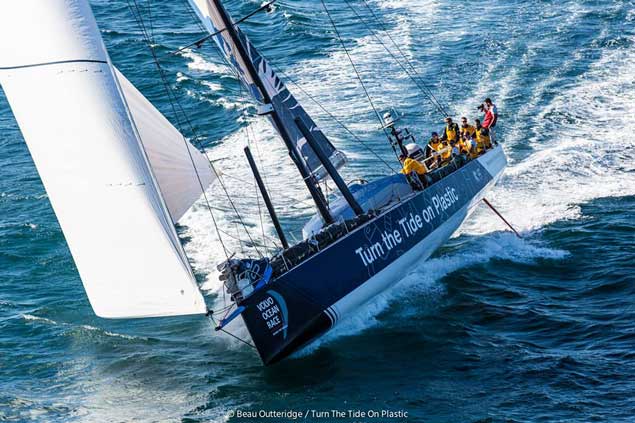 A very different machine from a Laser Radial – Silver Medallist Annalise Murphy is one of the round the world crew on turn the Tide on Plastic
A very different machine from a Laser Radial – Silver Medallist Annalise Murphy is one of the round the world crew on turn the Tide on Plastic
But despite these enormous difference, the fact of offshore racing becoming linked to the Olympics might make life a little easier for people like Tom Dolan who have literally re-invented themselves in the strange world of solo offshore racing, but find it extremely difficult to explain to non-sailors, especially those who might have a sponsorship budget, just what’s going on. However, mention the Olympics, and it’s a bit of a light-bulb moment.
That said, the proposed Olympic offshore course will be light years away from what Tom Dolan and his comrade-rivals put themselves through during the first 15 and more days of November. We carried an extract of winner Erwan Le Daroulec’s take on it earlier this week, but it’s worth repeating (and don’t sign off, the real meat of this week’s blog is at the end). Le Draoulac wrote:
“I brought a book with me, but I never thought to read it. I helmed, I ate, I slept, I answered the calls of nature, a real animal life. It was a nightmare.
The boat was soaked the whole time. I never dumped any sails, I just went up forward to reinforce my bowsprit. To get to sleep when I was under autopilot, I put on my headphones with some audio books and I listened again to the whole of Harry Potter. It was the only way of preventing stress whilst the boat was powering along at 18 knots, sometimes under autopilot, but I never eased off the pace.
It was only in the last two days where I dropped the large spinnaker in the squalls. I said to myself that it would be too silly to break everything so close to the goal. Prior to that though I really attacked hard. I knew I was risking a dismasting, but my line of thinking was that I was only twenty years old and that I’d have the opportunity to do another Mini-Transat. I didn’t make the most of it, I didn’t enjoy it. I’d like to the cross the Atlantic again, but gently so as to make the most of it.”
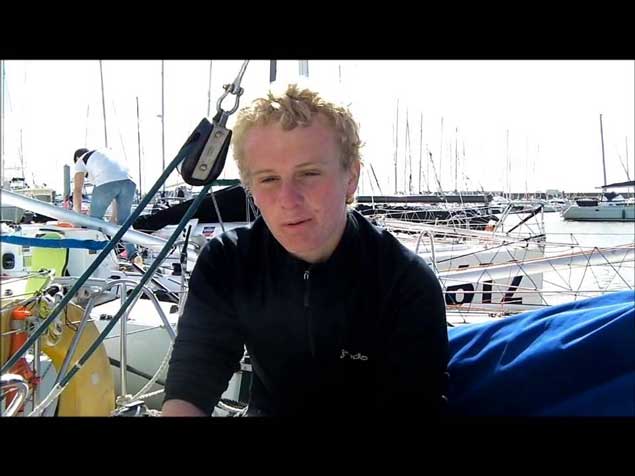 Erwan le Draoulec – he won, and won well, but says he didn’t enjoy it at all
Erwan le Draoulec – he won, and won well, but says he didn’t enjoy it at all
We really must try a dose of the old Harry Potters the next time insomnia comes along…..but seriously, what sort of a sailing world have we created, that a 20-year-old old is trained to such a level of performance that he can turn in an incredibly brave and skilled world-beating performance, yet actually hates every minute of it?
That said, Tom Dolan reckons he only feels truly alive when he’s “in the zone”, racing his little boat flat out. However, since he finished he has quietly revealed that, two days out from the finish, he survived an experience which was beyond fulfilling.
He was running in the dark in about 30 knots of wind and going a dream under the small spinnaker, nicely on track for fourth with a good chance of a bite at third, when out of the still-total blackness a 45 knot squall struck. IRL 910 went faster and faster, then a steep one lifted her from astern, and the tip of her stemhead went under the bow-wave. Within seconds, she’d done a complete pitchpole.
Tom found himself in the water in the dark, and his boat inverted for what seemed forever beside him. But she shook herself upright, he hauled himself aboard, and to his amazement everything, rig and all, still seemed intact. It was the first time he’d ever heard of a Min-Transat boat pitch-poling and not being dismasted, and miraculously it had happened to an under-funded Irishman who was campaigning on little more than wing and a prayer. He still had his wing. He will have sent have up a little prayer of thanks.
Then it was right back full on into the race, and we’ve all seen the vid of him finishing. But it’s worth repeating. You’re looking at a real hero.
He was within 48 minutes of being third and on the podium, but it was miraculous he was there at all. As for the final overall placings based on the total accumulated times for the two legs, the word is that won’t be officially announced until the Paris Boat Show on December 8th, when they’ll also stage the prize-giving.
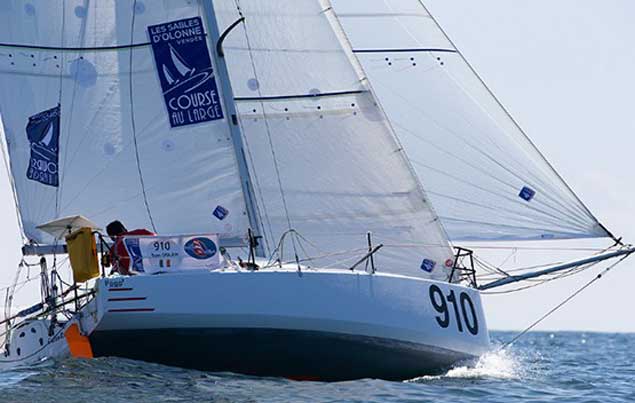 Tom Dolan with his new boat in 2016, when he won his first race. It has been revealed that he came fifth in the second leg of the Mini Transat despite being pitch-poled two days before the finish
Tom Dolan with his new boat in 2016, when he won his first race. It has been revealed that he came fifth in the second leg of the Mini Transat despite being pitch-poled two days before the finish
At the Paris Boat Show they’ll also officially announce the Golden Globe 18, golden oldies of a past era racing round the world in celebration of the Golden Jubilee the original Golden Globe, the non-stop round the world solo race of 1968 which was won by Robin Knox-Johnston in Suhaili. To be eligible, you have to be racing a “closed profile” (ie non fin-and-keg) boat of around 36ft, and Ireland’s Gregor McGuckin is entered with a Biscay 36 which he is currently preparing.
But as the organisers couldn’t get any British port associated with the original race to take it on fifty years later, Les Sables d’Olonne in France, home of the Vendee Globe, stepped up to the plate, and they will be the host port. It’s a perfect illustration of the huge spread of French interest in offshore racing. In fact, you might be making a sensible wager if you bet on France to support the new offshore event in the Olympics, but only if they can present the medals at the subsequent Paris Boat Show…
Meanwhile, as to Ireland being ready and willing for involvement in an Olympic offshore racing class, we certainly have plenty of keen young ocean racers, both men and women, who will be mustard keen if the resources can be found to get their campaigns under way. But as it is, the world of offshore racing is already rich in its diversity without being forced into any Olympic straitjacket. And that’s the way it is in Ireland too. We seem to like it that way too, but if the Olympics come calling, they’ll be welcome to join the party.
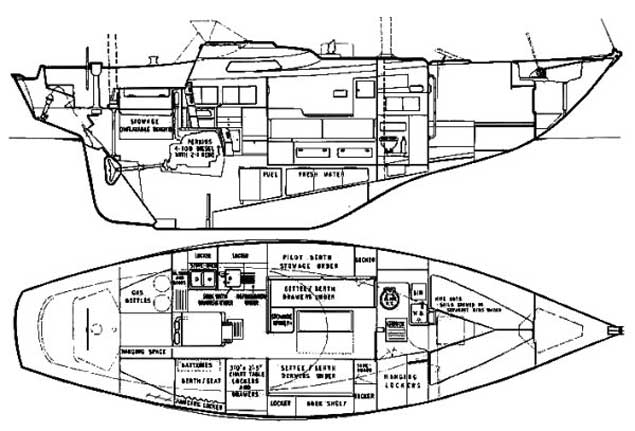 Tough and compact – the hull profile of a vintage Biscay 36. Ireland’s Gregor McGuckin will be racing one in next year’s Golden Jubilee of the Golden Globe Race. But despite the original having started and finished in England, the 2018 version will start and finish in France
Tough and compact – the hull profile of a vintage Biscay 36. Ireland’s Gregor McGuckin will be racing one in next year’s Golden Jubilee of the Golden Globe Race. But despite the original having started and finished in England, the 2018 version will start and finish in France































